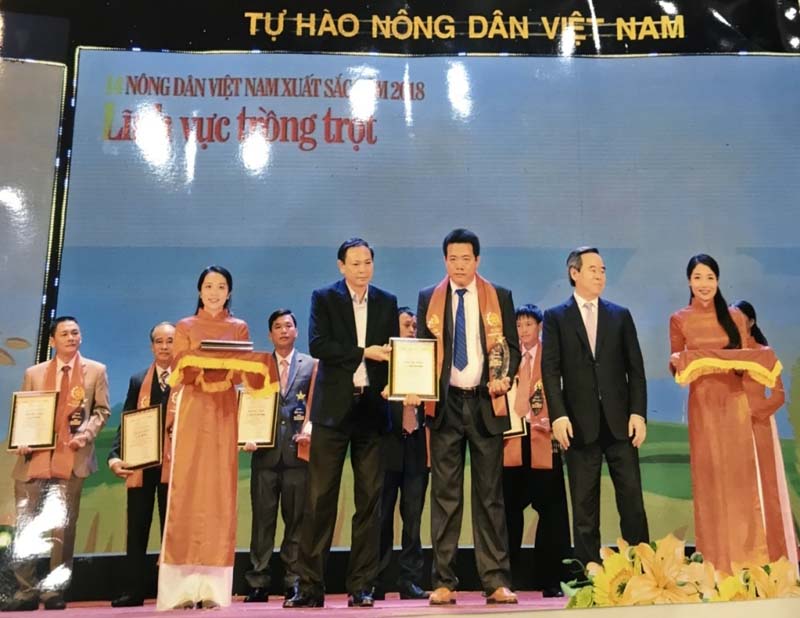
(HBO) - Mr. Tran Van Minh living in Diem Tong hamlet, Lien Son commune, Luong Son district has boldly developed the economy, to eradicate hunger and reduce the poverty. For 5 consecutive years, he has been recognized as an excellent farmer in producing and doing the business at National level; in October, 2018, the Association of Vietnam Farmers Association in cooperation with the Department of Propaganda and Education honored him as one of the 63 " the outstanding Vietnamese farmers" in 2018.

Mr. Tran Van Minh was awarded the title of
"Excellent Vietnamese Farmer" in 2018.
Mr. Tran Van Minh started his farming and
breeding career in 2004.
To exploit the potential and strengths of the
locality, he decided to expand the area and scale of production gradually every
year. Currently, his family has accumulated 45 hectares of land, over 40
hectares of which is the forestry land for planting acacia and eucalyptus
trees. To improve the efficiency, he combined cattle grazing with the total
herd ranging from 45 to 60 animals. At present, there are 36 cows and 18
buffaloes, including 15 mother cows, 8 mother buffaloes in good health for
breeding. Every year, he exploits to sell partially from 8 to 10 hectares of
commercial acacia and exports 15-20 cows, earning the interest from 400-450
million dongs.
Mr. Minh also planted 4,5 hectares of
planting galangal, lemongrass in the lower foothills, for a stable harvest of
45 - 50 tons, excluding the expenses, this brings to him about 600 million VND
per year. In the garden near his house, he planted 1 hectare of Dien grapefruit
for the shade and high economic efficiency, which he can collect the profit of
150 million VND each year. On average every year, his family earns 1.2 billion
dong of interest from the cultivation and husbandry model.
Not satisfied with only farming and
husbandry, in 2010, he continued to invest in business services transportation,
construction machinery. His family currently has a pickup truck, 3 excavators,
bulldozers to serve the work of the family, and meet the needs of production
machinery for local people in the region. Each year, his family earns 4.5
billion VND, after excluding expenses, the profit reached 3 billion VND. With
this economic model, his family has created regular jobs for 5 - 7 laborers,
sometimes attracting 30 seasonal workers in the locality.
According to data from the Hoa Binh Provincial Party Committee, the industrial production index for the first six months of 2025 is estimated to have increased by 20% compared to the same period last year. This marks the highest year-on-year growth rate for this period since 2020.
In the first six months of 2025, Hoa Binh province’s export turnover was estimated at 1.145 billion USD, marking an 18.11% increase compared to the same period in 2024. Import turnover was estimated at $ 804 million, a 17.15% increase, which helped the province maintain a positive trade balance.
The lives of the ethnic minority farmers in Tan Lac district have gradually improved thanks to the new directions in agricultural production. This is a testament to the collective strength fostered through the professional associations and groups implemented by various levels of the district’s Farmers’ Union.
With the motto the "product quality comes first,” after nearly one year of establishment and operation, Muong village’s Clean Food Agricultural and Commercial Cooperative, located in Cau Hamlet, Hung Son Commune (Kim Boi district), has launched reputable, high-quality agricultural products to the market that are well-received by consumers. The products such as Muong village’s pork sausage, salt-cured chicken, and salt-cured pork hocks have gradually carved out a place in the market and they are on the path to obtaining the OCOP certification.
In the past, the phrase "bumper harvest, rock-bottom prices" was a familiar refrain for Vietnamese farmers engaged in fragmented, small-scale agriculture. But today, a new spirit is emerging across rural areas of Hoa Binh province - one of collaboration, organisation, and collective economic models that provide a stable foundation for production.
Maintaining growing area codes and packing facility codes in accordance with regulations is a mandatory requirement for agricultural products to be eligible for export. Recently, the Department of Agriculture and Environment of Hoa Binh province has intensified technical supervision of designated farming areas and packing facilities to safeguard the "green passport" that enables its products to access international markets.



